|
The practice of tarring and feathering as punishment began in the 1100s when Richard the Lionheart began using it to punish thieves. It consists of removing a person's clothing, pouring hot tar on them and then covered with feathers that would stick to the tar. As you can imagine, the hot tar caused severe blistering and was incredibly painful to remove. The feathers made this even more difficult. Why tar and feathers? This form of intimidation and punishment was used extensively during the American Colonial Period, especially the 1760s when Patriots used it against Loyalists and British officials. Tar could easily be found in shipyards. Pine tar was applied between the boards in ships to make them water-proof. Most pillows of the time were stuffed with feathers, so they, also, were easy to obtain. Tarring and Feathering was not usually fatal. The tar was painful and the feathers were intended to make the person appear comical. It was designed to embarrass and humiliate the victim. Sometimes, a person's clothing was left on when they were tarred and feathered as a lesser punishment or warning. Because the tar was heated to make it spreadable, it often caused blistering when applied to bare skin. When a victim tried to remove the tar, their blistered skin was also removed. This was, of course, incredibly painful, but the beatings and other tortures that frequently went along with tarring and feathering were often more life-threatening. Did it work? Tarring and feathering was successful. Tax collectors were often threatened. Though there are no records of a stamp commissioner being tarred and feathered, the threats were enough that when the Stamp Act tax went into effect in 1765, there were no stamp commissioners left in the colonies to collect it. It was also successful in protesting the Townshend Duties which included the tea tax that led to the Boston Tea Party. Other materials were used to exact the same punishment such as syrup instead of tar or cattails instead of feathers. John Robert Shaw described a tarring and feathering in his autobiography: in this excursion, among other plunder, we took a store of molasses, the hogshead being rolled out and their heads knocked in, a soldier’s wife was stooping to fill her kettle, a soldier slipped behind her and threw her into the hogshead ; when she was hauled out, a bystander then threw a parcel of feathers on her, which adhering to the molasses made her appear frightful enough;–This little circumstance afforded us a good deal of amusement. “ A New Method of Macarony Making, as Practised at Boston in North America.” Wikimedia Commons, British Museum, https://commons.wikimedia.org/wiki/File:A_New_Method_of_Macarony_Making,_as_practised_at_Boston_in_North_America_(BM_J,5.67).jpg. Accessed 11 Jan. 2023. Bell, J. L. “5 Myths of Tarring and Feathering.” Journal of the American Revolution, 28 Aug. 2016, https://allthingsliberty.com/2013/12/5-myths-tarring-feathering/. Brainard, Jennifer. “Tarring and Feathering .” History Wiz, 2008, http://www.historywiz.com/didyouknow/tarringandfeathering.htm. https://web.archive.org/web/20190309190342/http://www.historywiz.com/didyouknow/tarringandfeathering.htmBurns, Janet. “A Brief, Sticky History of Tarring and Feathering.” Mental Floss, Mental Floss, 6 Aug. 2015, https://www.mentalfloss.com/article/66830/brief-sticky-history-tarring-and-feathering. “John Meintz, Punished during World War I.” Wikimedia Commons, U.S. District Court for the Second (Mankato) Division of the District of Minnesota, 2016, https://commons.wikimedia.org/wiki/File:John_Meintz,_punished_during_World_War_I_-_NARA_-_283633_-_restored.jpg. Accessed 11 Jan. 2023. Leslie, Frank. “1862 Kimball of Essex Democrat Haverhill from FrankLeslies.” Wikimedia Commons, Frank Leslie's Pictorial History of the American Civil War, 2012, https://commons.wikimedia.org/wiki/File:1862_Kimball_of_Essex_Democrat_Haverhill_from_FrankLeslies.jpeg. Accessed 11 Jan. 2023. “Liberty! . The Stamp Act Riots & Tar and Feathering.” PBS, Public Broadcasting Service, https://www.pbs.org/ktca/liberty/popup_stampact.html. Seaver, Carl. “The Strange History behind Tarring and Feathering.” History Defined -, 22 July 2022, https://www.historydefined.net/tarring-and-feathering/. This is adapted from a page on the Boise State University website created by created by Stefanie Welty that is no longer published.
PLOT AND THE PLOT DIAGRAM Plot is the series of events in a story that explain to the reader what is happening. One of the easiest ways to understand plot is to look at the mountain shaped plot diagram and think of story in terms of climbing a mountain. Stage 1 - Exposition
Stage 2 - Rising Action
Stage 3 - Climax
Stage 4 - Falling Action
Stage 5 - Resolution
Conflict Every story has a conflict - a struggle between two opposing forces. The conflict may be between two people or it may be between a person and some other force such as the weather, a problem, or even a problem a character has with themself. Since every story revolves around conflict, it is important to understand the two kinds of conflict.
Ernst Morch, born in 1908, was an important doctor in the field of anesthesiology (using gases or drugs to lessen pain, especially before surgery). He became interested in this when he was 5 years old and had his tonsils removed without any anesthesia, which was incredibly painful. He developed medical equipment, learned new techniques, and administered new drugs that helped advance medicine and make surgeries far less painful. World War II activities
The Nazis didn't want news about what was really happening in the war to get out to the public, so Dr. Mørch and his colleagues set up a receiver on the roof of the hospital so they could listen to the BBC—the British Broadcasting Company that was a radio station reporting on the war. They then reported what they heard in their underground paper. They also snuck out information they learned about the Nazis to authorities in England. Saving Danish jews
His second life-saving formula After the war, Dr. Mørch rode on one of the buses sent by the Danish government to Buchenwald Concentration Camp in Germany to bring home the Danish citizens who were held there. The prisoners there had been starved for a long time, so when they were given food and milk, they quickly died because their bodies couldn't handle suddenly eating and drinking like normal. Dr. Mørch figured out that small shots of beer, given every 30 minutes along with injected vitamins over the slow ten-day drive back to Denmark, could save thousands. These buses ended up transporting more than just the Danish people and ended up saving 280,000 concentration camp victims. Bessette, Claire. “Son of Danish WWII Hero Relays Events to Norwich Students.” The Day, 24 Feb. 2016, https://web.archive.org/web/20160225093140/www.theday.com/article/20160223/NWS01/160229657. Rosenberg, Henry, and Jean K. Axelrod. “Ernst Trier Mørch: Inventor, Medical Pioneer, Heroic Freedom Fighter.” Anesthesia & Analgesia, International Anesthesia Research Society, https://journals.lww.com/anesthesia-analgesia/fulltext/2000/01000/ernst_trier_m_rch__inventor,_medical_pioneer,.43.aspx. January 2000 - Volume 90 - Issue 1 - p 218-221 The map above shows the Caribbean as it is today. Columbus spent the most time on an island called Haiti (though some think it was called Quizquella). He renamed it La Isla Española. When France took over the island it was called Santo Domingo (or Saint Domingue in French). Today the countries of Haiti and The Dominican Republic make up the island, now known as Hispaniola. before columbus The people who originally lived on the island we now know as Hispaniola were Taíno. As many as 750,000 Taíno were living on Hispaniola when Columbus first arrived. They lived on many of the islands in the Caribbean, but most historians agree that the largest population of Taíno were on Hispaniola. Other large populations were living on the islands of Cuba and Puerto Rico. A reconstruction of a Taíno village in Cuba. Taíno women were highly skilled in agriculture (growing food), while the men hunted and fished. They were skilled artisans making beautiful pottery, intricate belts woven from dyed cotton, and they carved incredible images from stone, wood, shell, and bone. Some of the first Spanish who met and wrote about them said they had well-organized communities with each village having a chief known as a cacique if it was a man or a cacica if it was a woman. Villages were then grouped into districts headed by one of the village cacique or cacica. These districts were then grouped into a region headed by the most prominent district cacique or cacica. This organizational structure is similar to the political structure of the United States with mayors, governors, senators, etc. It seems the Taíno were not used to battle or warfare because Columbus wrote, "They traded with us and gave us everything they had, with good will . . . they took great delight in pleasing us. They are very gentle and without knowledge of what is evil; nor do they murder or steal. Your highness may believe that in all the world there can be no better people . . . They love their neighbours as themselves, and they have the sweetest talk in the world, and are gentle and always laughing." He also wrote, "With 50 men you could subject everyone and make them do what you wished." He eventually did just that. Many of the words you know are from the Taíno language including hammock, hurricane, canoe, and tobacco. depopulation Columbus wrote of the Taíno people, “They will give all that they do possess for anything that is given to them, exchanging things even for bits of broken crockery. . . . They were very well built, with very handsome bodies and very good faces. . . . They do not carry arms [weapons] or know them. . . . They should be good servants.” He and his men enslaved Taíno men, women, and children and forced them to search for gold, build their settlements, and do any other task they wished. Failure to find gold or work as they expected was met with cruel and vicious punishment, and sometimes death. After finding very little gold on his second journey in 1493, and needing a cargo other than gold and spices to ship to Spain, Columbus decided to send the Taíno people he had enslaved as a show of the wealth available in the New World. He loaded the "best men and women" onto ships and sent them off to Europe. This was just the beginning of the widespread enslavement of the Native Peoples. Within thirty years, 80-90% of the Taíno population had died from disease, starvation, or brutal treatment. Baracutei Estevez, Jorge. "On Indigenous Peoples' Day, Meet the Survivors of a 'paper Genocide'." History. National Geographic, 04 May 2021. Web. 7 July 2022.
"Hispaniola." Wikipedia. Wikimedia Foundation, 04 May 2022. Web. 16 June 2022. Kmusser. "Caribbean General Map." Wikimedia Commons. Wikipedia Foundations, 9 Apr. 2011. Web. 17 June 2022. "Native Peoples-the "Indians"." Journey of Christopher Columbus. Glencoe/McGraw-Hill Publishing. Web. 16 June 2022. Poole, Robert M. "What Became of the Taíno?" Smithsonian.com. Smithsonian Institution, 01 Oct. 2011. Web. 16 June 2022. "Spanish Settlers Enslave the Taíno of Hispaniola - Timeline - Native Voices." U.S. National Library of Medicine. National Institutes of Health. Web. 17 June 2022. Information in this post was adapted from the Sacramento Bee gold rush website that is no longer published. As news of James Marshall's 1848 discovery of gold at Sutter's Mill spread, people from around the world began making the trek to California to seek fortune. In 1849, the steady stream of people from within the United States had established three main routes to California. The overland route TRAVEL TIME: about 4 months DISTANCE: approximately 2,000 miles COST: $600-$700 for a family of four Travel often began by steamboat up the Ohio or Mississippi River to reach the trailheads. The most common "jumping off" point was Independence, Missouri. The Oregon trail had been traveled by fur trappers for decades.
Dangers Sickness The biggest killer along the trail was disease. According to the National Parks Service, of the 350,000 people who traveled by land, they estimate 30,000 people died of disease over the 20-25 years the Emigrant Trail was active. The most common was cholera—a bacteria that caused severe diarrhea and dehydration killing many. Some got it and died before even leaving Independence. Dysentery, from dirty drinking water, also killed many. Guns A common fear was attack from the Native People, though this almost never happened. This fear, however, meant the overland travelers were well armed. Inexperience with guns and cheaply made weapons were a problem, and gunshot wounds were common. Hunting along the route was necessary (and often done just for fun, too) so hunting accidents occurred and diaries of the journey often mention someone shooting themselves while mishandling their own gun. River crossings At that time, most people didn't know how to swim. Many died from drowning at river crossings as they tried to get animals and wagons across. If it had recently rained, rivers would be larger and more dangerous, so wagon trains sometimes waited for several days for the river's flow to lessen. Accidents Gunshot and drowning weren't the only accidents that happened. Walking 10-15 miles per day, every day, for months, meant people and animals were exhausted, which made them careless. Examples of other accidents that happened include being kicked or dragged by oxen or horses or crushed by wagon wheels. Weather The weather on the plains could be severe. Tornadoes, prairie fires, lightning, and hailstones big enough to kill a man were recorded. Crossing the desert meant incredible heat and dehydration. The mountain crossings meant even more problems as snow often occurred, even in summer months. Supplying your wagon train Most overland travelers joined a wagon train, banding together for safety and to share resources. They often made sure to have people from many different occupations and abilities along so they would have experienced people to do things like hunt, repair broken wagon wheels, or set a broken bone.
Plates, silverware, pots and pans were kept in a special box on the back of the wagon. Space in the wagon was limited, so hooks and ropes tied to the wooden frame of the canvas covering the wagon or the outside of the wagon itself held milk cans, guns, etc. The sloshing milk in the can even churned butter as the wagon rumbled along the trail! Some brought chickens. Eggs were stored in flour barrels, where they were safe from breaking as long as they didn't touch. A bucket of grease was hung between the wheels. It was used to lubricate the wheels and axles of the wagon.
Two routes by sea #1 Around the horn Traveling by ship by going "around the horn" meant sailing all the way down the eastern shore of South America, and around the southern tip of the continent, known as Cape Horn. Costs and travel time varied greatly depending on circumstances. Nicer rooms that weren't as far below deck sold for more than hammocks strung between beams amongst dozens of other (usually) men. As demand for the sea route increased, so did prices. Travel time varied depending on the weather. Storms could mean an additional month at sea. Sometimes, when wind and currents were not favorable, ships would have to travel as far a Hawaii (then known as the Sandwich Islands) before being able to travel northward to San Francisco. This could add months to the trip. Most of the ships along this route were not designed as passenger ships. They were cargo ships that were quickly converted to carry passengers as more and more people began trying to get California. TRAVEL TIME: about 5 months DISTANCE: 18,000 miles COST: from $600 to more than $1,200 per person dangers Sickness Cholera was a problem on this route, too. Some died, but not nearly as many as on the overland route. Scurvy—a disease caused by lack of vitamin C—made some very sick and killed a few. Sea sickness was a big problem, but almost no one died from just being seasick.
Weather Being out at sea meant there was no shelter from storms. Lack of wind was also a problem, which could leave a ship stranded for days or weeks. As food and water supplies were used up, this could quickly become a dangerous problem. supplying the ship Keeping the ship stocked with supplies was difficult. Supplies might include: Salt pork, salt beef, ham, hard bread, salt, 40 pounds of butter and cheese, tea, sugar and spices. One advantage of this route was that the ship could stop at ports along the way to resupply.
#2 crossing the isthmus
TRAVEL TIME: at first, this route would take as little as 3 months, but by 1850 when ships were added along the Pacific coast, the trip was only 6 - 8 weeks DISTANCE: 10,000 miles COST: the cost varied greatly—it was about $400 to get from New York City to the east coast of Panama and then across the isthmus to Panama City on the west coast. They sometimes had to wait weeks before a ship arrived with room to take them from Panama to San Francisco. Not only did they have to pay for this, which was sometimes very expensive, but they often had to wait weeks or even months for a ship came along with room to take them. While waiting, they had the additional expense of having to have a place to stay in Panama City. This is an 1850 illustration by Charles Christian Nahl of a boat taking travelers up the Chagres River in Panama. dangers Sickness Like the other routes, disease was a major problem. Cholera and dysentery killed some, but crossing the isthmus also meant many got yellow fever or malaria from mosquito bites. Thousands died along this route of disease. Afong, Lai. “Guangzhou, Chinese Boats by Lai Afong, Cа 1880.” Wikimedia Commons, 2015, https://commons.wikimedia.org/wiki/File:Guangzhou,_Chinese_Boats_by_Lai_Afong,_c%D0%B0_1880.jpg. Accessed 23 Feb. 2022.
“The American Experience | Wayback: Gold Rush | Journey of the Forty-Niners: Around Cape Horn.” PBS, Public Broadcasting Service, http://www.shoppbs.pbs.org/wgbh/amex/kids/goldrush/journey_capehorn.html. “Antiope.” Https://Npgallery.nps.gov/ , National Parks Gallery , 1893, https://picryl.com/amp/media/antiope-built-1866-bark-3m-commencement-bay-wa-circa-1893-1905-010fcb. Accessed 23 Feb. 2022. Bayer, Alicia. Around the Horn, 2010, http://magicalchildhood.com/games/aroundthehorn.htm. Bonfield, Lynn A. “When Money Was Necessary to Make Dreams Come True: The Cost of the Trip from Vermont to California via Panama.” Vermont Historical Society, 2008. https://www.google.com/url?sa=t&rct=j&q=&esrc=s&source=web&cd=&ved=2ahUKEwjQrLrhvpb2AhV7IUQIHRloBQUQFnoECBgQAQ&url=https%3A%2F%2Fvermonthistory.org%2Fjournal%2F76%2FVHS760202_130-148.pdf&usg=AOvVaw37S6RL8D-vF-xQW93EGoLH “Cholera: A Trail Epidemic (U.S. National Park Service).” National Parks Service, U.S. Department of the Interior, https://www.nps.gov/articles/000/cholera-a-trail-epidemic.htm. “Death and Danger on the Emigrant Trails (U.S. National Park Service).” National Parks Service, U.S. Department of the Interior, https://www.nps.gov/articles/000/death-on-trails.htm. Famartin. “Humboldt Basin.” Wikimedia Commons, 18 May 2015, https://commons.wikimedia.org/wiki/File:2015-04-18_15_36_28_Panorama_of_the_Humboldt_Sink_from_the_West_Humboldt_Range_in_Churchill_County,_Nevada.jpg. Accessed 22 Feb. 2022. Ford, Dixon, and Lee Kreutzer. “Overland Journal.” 2015. “Gold Rush.” Internet Archive, The Sacramento Bee, https://web.archive.org/web/20210114193358/http://www.calgoldrush.com/. Kemble, John Haskell. “The Gold Rush by Panama, 1848-1851.” Pacific Historical Review, vol. 18, no. 1, 1949, pp. 45–56., https://doi.org/10.2307/3634427. Accessed 23 Feb. 2022. Nahl, Charles Christian. “Der Isthmus Von Panama Auf Der Höhe Des Chagres River.” Wikimedia Commons, 2008, Berkeley, California, https://commons.wikimedia.org/wiki/File:Nahl_1850,_Der_Isthmus_von_Panama_auf_der_H%C3%B6he_des_Chagres_River.jpg. Accessed 23 Feb. 2022. Rydell, Raymond A. “The Cape Horn Route to California, 1849.” Pacific Historical Review, vol. 17, no. 2, 1948, pp. 149–163. JSTOR, https://doi.org/10.2307/3635514. Accessed 23 Feb. 2022. Tentotwo. “Fort Hall Location.” Wikimedia Commons, 18 Oct. 2015, https://commons.wikimedia.org/wiki/File:Fort_Hall_Location_Map.png. Accessed 22 Feb. 2022. Unknown author. “Unidentified Tall Ship near Cape Horn.” Wikimedia Commons, National Library of Australia, 2011, https://commons.wikimedia.org/wiki/File:Unidentified_tall_ship_near_Cape_Horn_-_Nla.pic-vn3299637-v.jpg. Accessed 23 Feb. 2022. Unknown author. “Wagon Train.” Wikimedia Commons, 19 Aug. 2007, https://commons.wikimedia.org/wiki/File:Wagon_train.jpg. Accessed 23 Feb. 2022.
In the animation above you can see how the states within México, the U.S. - México border, and the border with the Republic of Texas changed throughout the years. Because of these border changes, Mexican Americans say, "We didn't cross the border, the border crossed us."
Through war and sale, tens of thousands of Mexican citizens suddenly became United States citizens. Something else to consider? Canada, México, and 31 other countries are on the American continents—North and South America. We, in the United States, sometimes irritate or insult people in these other countries by calling ourselves "American" because they, too, are American. In French speaking Quebec in Canada, United States citizens are called Etats-Uniens. In many Latin American countries, United States citizens are called estadounidense. Both of these mean United States-ian. “Becoming Part of the United States : Mexican : Immigration and Relocation in U.S. History : Classroom Materials at the Library of Congress : Library of Congress.” The Library of Congress, www.loc.gov/classroom-materials/immigration/mexican/becoming-part-of-the-united-states/. Golbez. “Mexico States Evolution.” Wikimedia Commons, Aug. 2013. https://commons.wikimedia.org/wiki/File:Mexico_states_evolution.gif Martinez-Carter, Karina. “What Does 'American' Actually Mean?” The Atlantic, Atlantic Media Company, 20 June 2013, www.theatlantic.com/national/archive/2013/06/what-does-american-actually-mean/276999/. The Niña, the Pinta, and the Santa Maria The names of the ships probably weren't the Niña, the Pinta, and the Santa Maria. At the time, Spanish ships had official religious names, but were generally known by their nicknames. The Niña is believed to be the nickname for the Santa Clara. The Santa Maria was known at the time as La Gallega. The Pinta was probably also a nickname, but the official name isn't known. Two logs Columbus kept two logs of the distance they traveled. The one he showed to the crew showed they had not gone as far as they really had. He did not want them to think they were too far from home because he feared they would want to turn back as supplies ran low. On the 14th of September, 1492, some terns were spotted. This was a bird that was known to stay fairly close to land, so Columbus thought this was a sign that they were getting close. By the 16th, land still had not been sighted. The sailors had never been away from land for so long, so they were growing more fearful. The days passed slowly. The crew demanded they turn around and go home and there were whispers of mutiny, but Columbus managed to calm them. Throughout the journey the crew took any small token as a sign of land, bits of seaweed, crabs, birds, whales, and even a drizzling rain. Finally, land was sighted on the 12th of October, 1492. Columbus did not discover America The two continents known now as North and South America were home to millions of people for at least 20,000 years before Columbus was born! In fact, he isn't even the first person from Europe to visit North America. More than 400 years before Columbus lived, Vikings, who sailed from Greenland, lived in North America. The built villages and stayed for about ten years. Columbus was a terrible person When Columbus landed on the island that is now known as Hispaniola, he met the Native People who were friendly as they traded supplies with the sailors. In his diary, Columbus described them as "very well built, with very handsome bodies and very good faces. They do not carry arms [guns or swords] or know them. . . . They should be good servants." He soon forced them into slavery and punished them with losing an arm, or even death, for not finding enough gold. He wasn't any better with the Spanish who returned to the island on his second and third trips. They were flogged (beaten with whips) and executed without a trial. In fact, when the King and Queen of Spain heard about his bad behavior, he was arrested and returned to Spain in chains. Groeneveld, Emma. “Vinland.” Ancient History Encyclopedia, Ancient History Encyclopedia, 15 Jan. 2021, www.ancient.eu/Vinland/. Mikkelson, David. “What Were the Names of Christopher Columbus' Three Ships?” Snopes.com, 12 Oct. 2020, www.snopes.com/fact-check/columbus-ships-names/. Myint, B. “Was Christopher Columbus a Hero or Villain?” Biography.com, A&E Networks Television, 8 Oct. 2020, www.biography.com/news/christopher-columbus-day-facts. Strauss, Valerie. “Christopher Columbus: 3 Things You Think He Did That He Didn't.” The Washington Post, WP Company, 22 Apr. 2019, www.washingtonpost.com/news/answer-sheet/wp/2013/10/14/christopher-columbus-3-things-you-think-he-did-that-he-didnt/. Weiner, Eric, and Russell Freedman. “Coming to America: Who Was First?” NPR, NPR, 8 Oct. 2007, www.npr.org/templates/story/story.php?storyId=15040888. This page was adapted from a description and drawing of frontier cabins that was on the state of Utah website that is no longer published. Log cabins were common in Eastern Europe and Scandinavian countries—places like Germany, Sweden, and Norway. When people from these countries moved to North America (before the United States existed) they brought their style of home with them. Using only an axe, a log cabin could be built in just a few weeks (even a few days with enough people working on it). This is what made them so popular. 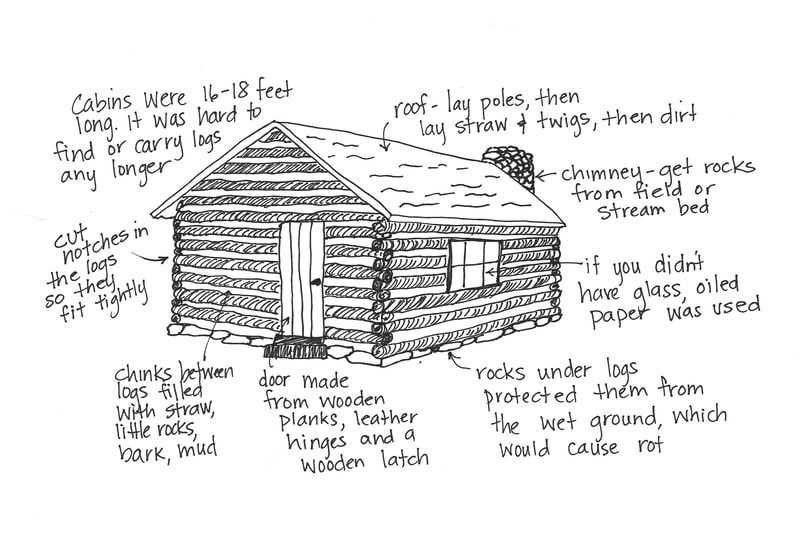 Log cabins were typically only one room that the entire family cooked, ate, and slept in. They weren't designed to last forever, they were easy to build with just an axe, so you could provide shelter for family quickly. Though the Salem Witch Trials are more famous, many New England colonies had their own shameful witch trials. Connecticut had the first in 1647. In all, Connecticut had 43 witch trials with 16 executions (being killed for committing a crime). Here, we'll focus on those in Wethersfield since this is the setting for the book The Witch of Blackbird Pond. In the book, the "witch," Hannah, is a Quaker, and while it is true that being a Quaker meant you were often persecuted like Hannah is, by being branded and chased out of town, they usually weren't labeled witches just for being a Quaker. In the 1600s, it was believed that a witch had made a deal with the devil which gave them supernatural powers like being able to make people sick or bring storms. This was a time when science was lacking. There were no hospitals, no police force, and no army. People didn't know germs existed or how storms developed. What people don't understand, they often fear and there was much to fear in Colonial America. As Chris Pagliuco states in his article Wethersfield's Witch Trials: They could lose their sheep and other farm animals to wolf and bear attacks. The Connecticut River could flood at any time, wiping out crops. Epidemics visited the region in 1647 and 1648, killing dozens of townspeople in an already small and unstable population. The local Native Americans were equally dangerous. The Pequot War began with a "massacre" in Wethersfield in 1637; nine wethersfield residents were killed, two captured, and the entire population horrified. (Some wethersfield residents got their revenge weeks later with the slaughter of hundreds at the Pequot Massacre in Mystic.) Mary Johnson Two women are mentioned in The Witch of Blackbird Pond who were real people living in Wethersfield during the 1600s. Mary Johnson was a house servant who had been convicted (found guilty) of stealing in Hartford, Connecticut and then again in Wethersfield. People were already suspicious of those who were convicted of a crime, like stealing. People believed the devil walked around among them causing weak people to do bad things. If you stole something, you probably signed a deal with the devil (making you a witch). Mary Johnson is notable because she is the first person in North America to confess to witchcraft. While she was being whipped for stealing, she not only confessed to witchcraft, but even claimed to have killed. She was never put on trial for murder, however, so it seems the authorities didn't believe that confession. They did believe her confession of witchcraft, however, and she was executed in 1650. Katherine Harrison Often, people who were accused of witchcraft were those who were different, or those who challenged the typical way things were done. When she was younger, Katherine Harrison was a servant in Hartford. It was believed that the classes shouldn't mix, so the rich (one "class" of society) should never marry someone from the "lower classes," like servants. But, Harrison married a successful Wethersfield farmer who had lots of land, making her wealthy. When Harrison's husband died, people began accusing her of witchcraft within months, even though she had never been accused before. People didn't like the idea of her being able to move from the servant "class" to the rich "class," so perhaps witchcraft enabled her to do it. The townspeople looked at anything that went wrong or was suspicious as her fault. Connecticut state historian Walter Woodward explains, "If a child died unexpectedly, if there [was] a drought or if cheese rotted unusually fast, they believed it to be the work of the devil. The real test of being a witch was making a pact with the devil. They all believed in magic of some sort, but to cooperate with the devil was unacceptable. …You were considered extremely dangerous." One neighbor woman even accused Harrison of witchcraft because she spun "so great a quantity of fine linen yarn… [that she]…did never know nor hear of any other woman that could spin so much." Even though this sounds more like jealousy than witchcraft, Harrison was found guilty of witchcraft in 1669.
In other capital cases (ones in which someone could be executed), there had to be two witnesses, but in witch trials, those two witnesses could have "seen" two different instances of witchcraft. So, for example, one person could claim Katherine Harrison was a witch because their child got sick after she visited them and someone else could claim she was a witch because their goat died after she walked past it and mumbled.
Reverend Bulkeley had trained in medicine by John Winthrop Jr. and was also skeptical that so much witchcraft was going on in Connecticut towns. He used the questions Winthrop provided for them, which asked about the evidence in the case. Because there were not two witnesses to any one claim about Harrison's witchcraft, her conviction was overturned (she was found to be not guilty). This changed the standard for judging whether someone was a witch and from this time forward no other person was executed for being a witch in Connecticut. Though Katherine Harrison was found to be not guilty, she couldn't live in peace in Wethersfield any longer and moved to New York. |
Author
I often struggle to find websites with thorough explanations in simple language to help kids understand historical events or scientific concepts, so I decided to create some of my own! -Cookie Davis
Archives
March 2024
|

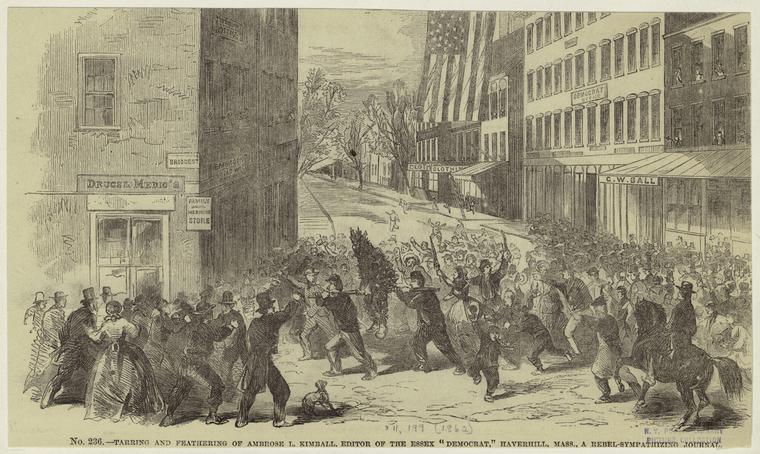





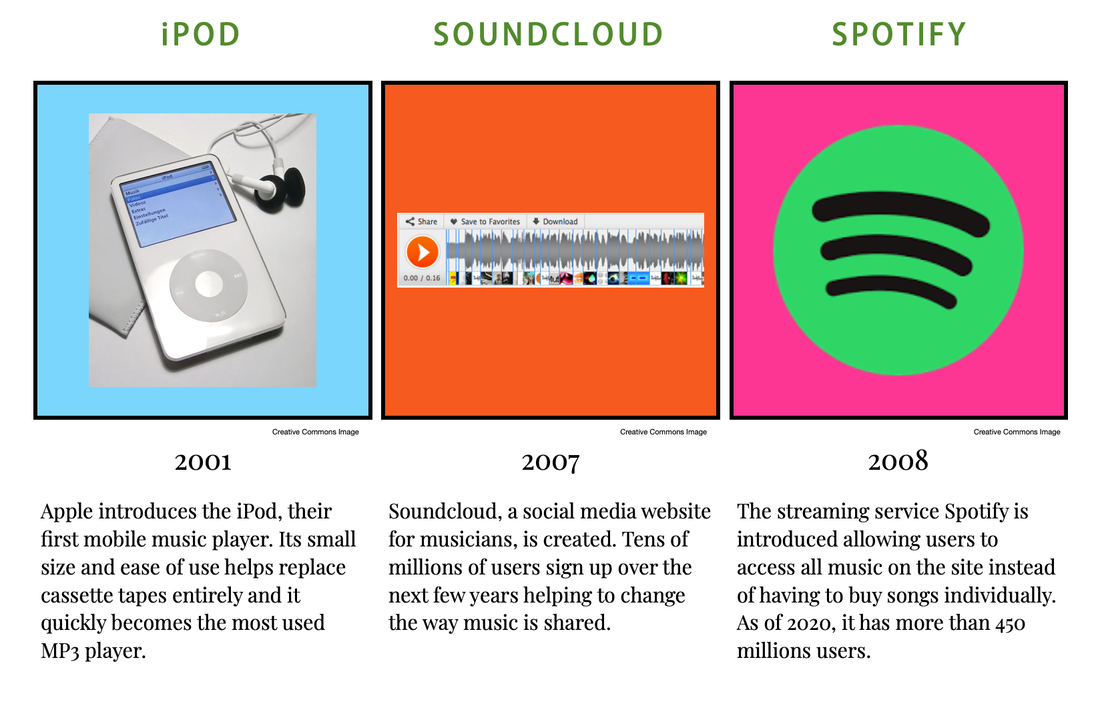

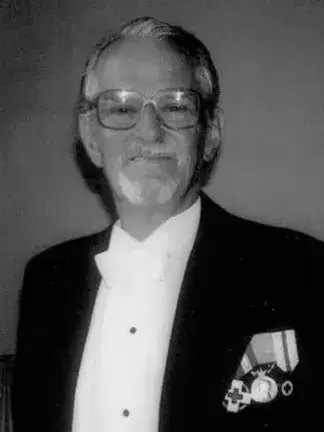


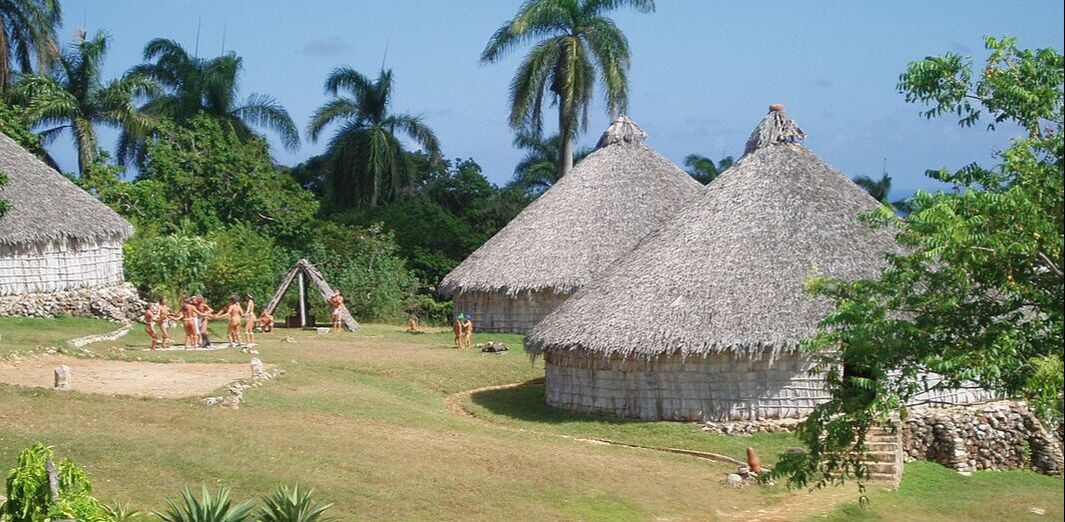














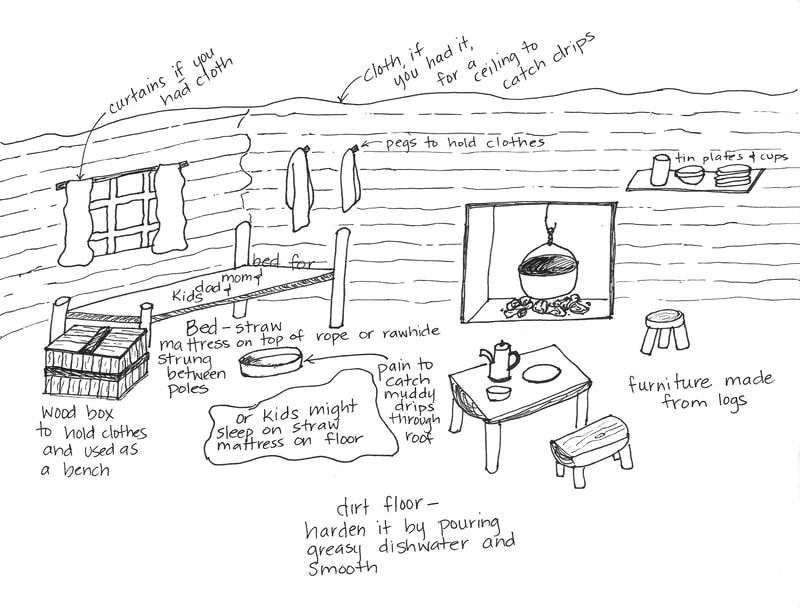



 RSS Feed
RSS Feed